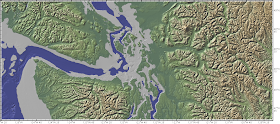During the last glacial period sea level was significantly lower due to the fact that a lot of water was stored within the masses of glacial ice covering the northern latitudes. So if one lowers the sea level and uses current bathymetry the former coast can be estimated.
As can be readily seen after doing that exercise, the outer coast would have been on the order of 40 miles further out from the present day coast. It also shows that a fair bit of what is now covered by the Salish Sea inland waters would be high and dry. But the story is a fair bit more complicated. The dry areas now under the Salish Sea would have been covered with ice and the mass of ice pushed down the land surface not only where the ice was present but for considerable distance away from the ice. Hence, former shorelines are found well above current shorelines in the Slash Sea. When the glacial ice retreated even the lower global sea level ocean inundated the inland areas that had been ice covered (isostatic-rebound-on-northwest-blakely and wave-cut-terraces-in-san-juans).
But something to consider on the outer coast is where would people have likely lived if they were in Washington during the ice age. Coastal settlements would now be under water. We do know that someone pushed a spear into the side of a mastodon 13,800 years ago (thoughts-on-manis-mastodon-and-western). Glacial ice still covered the northwest corner of the state at that time. Where did the hunter come from. One possible explanation that I tend to favor is that people traveled along the outer coast during the ice age. The map above would indicate that any coastal settlements would be lost, but some effort to identify sites where the combination of sea level and isostatic loading caused a stable shore area has been an area of ongoing research in British Columbia.


Maybe we don't absolutely know "that someone pushed a spear into the side of a mastodon 13,800 years ago" at the Manis site. According to Bax Barton, curator of Special Collections Resource Center, Quaternary Research Center at the Burke Museum, U of W, the bone point itself, embedded in the rib, has never undergone DNA analysis. It could be a tusk fragment. If that's the case, the death of the Manis mastodon may have been caused by a fight with another mastodon. As far as I know, no stone artifacts were found in association with the kill.
ReplyDeleteSusan: Check out this paper and the video as well:
ReplyDeletehttp://csfa.tamu.edu/cfsa-publications/Waters-etal-science334-2011.pdf
https://www.youtube.com/watch?v=sFK4FCvb82E
Thanks for those links. I did wonder, as it seemed odd not to have done analysis to the max of that point, given the prominence/notoriety of the site.
ReplyDeleteHey Dan,
ReplyDeleteNeat post on a subject near-and-dear to my heart. A further complication to the ice-age shoreline story is that most of those "dry areas" in the Salish Sea and Puget Sound would have looked significantly different during the last glacial sea-level low-stand (about 21 kyr ago) because those areas were severely modified by the Puget ice lobe when it advanced over the area ~18 kyr ago.
It's also curious to consider where exactly the ice was 13,800 yr ago when the Manis Mammoth was apparently killed: it would have been pretty much restricted to Whatcom County (and parts of BC further north). South B'ham was ice free by ~14 kyr ago (accd. to 14C dates from Lake Padden!) So we may have even had mammoths (and humans) in Whatcom Co by then!